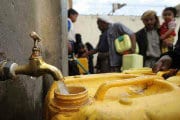Send to a friend
The details you provide on this page will not be used to send unsolicited email, and will not be sold to a 3rd party. See privacy policy.
Clashes over water are killing up to 4,000 people a year in Yemen, its government says.
These conflicts, which predate the country’s civil war, include raids on wells and other fights over water access involving armed groups, according to Yemen’s interior ministry.
“The conflict in Yemen is exacerbating water scarcity by reducing access to safe drinking water. If urgent action is not taken, the country will fall into further humanitarian crisis.”
Fawzi Karajeh, FAO Regional Office for the Near East and North Africa
This compares with more than 2,500 deaths so far in the civil war that began in March and involves an alliance led by Saudi Arabia fighting supporters of Ali Abdullah Saleh, a former president who was ousted in 2012.
According to a regional representative of the UN’s Food and Agriculture Organization (FAO), the civil war has left around 20 million Yemenis without access to drinking water.
“With the current conflict, the number of people that don’t have access to clean water is believed to be more than 80 per cent of the population,” says Abdessalam Ould Ahmed, who represents the FAO’s Near East and North Africa region.
Yemen has the highest water scarcity in the world, he says, with more than half the population lacking a regular supply of drinking water even before the fighting began.
Even in the capital, Sana’a, only 40 per cent of homes are connected to the water system, according to the Wilson Center, a US think-tank focusing on global challenges.
In 2009, a FAO report forecast that Yemen could be the first county to lose its ground water resources completely. Groundwater levels are falling by around two metres a year in some regions, it said.
With the conflict raging, the situation is close to “complete collapse”, warns Fawzi Karajeh, senior water resources and irrigation officer at the FAO Regional Office for the Near East and North Africa in Egypt.
“The conflict in Yemen is exacerbating water scarcity by reducing access to safe drinking water,” he tells SciDev.Net. “If urgent action is not taken, the country will fall into further humanitarian crisis.”On average, 115 cubic metres of water a year are available for every person in Yemen — just eight per cent of the world average. “If the conflict continues, it is expected that this will decline to 55 cubic metres per person per year in 2031,” says Karajeh.
Karajeh’s fears were confirmed by Omar Alhayani, an environmental journalist based in Sana’a. “In the area where I live, and some nearby places, the water crisis has reached a very dangerous level,” he says. “People are sometimes queuing for more than 24 hours to get a share of water.”
Alhayani describes how people use stagnant water from dams for drinking and cooking. He says the crisis is even bigger in Aden, where wells are the only source of water. Since pumps are mostly out of action due to the breakdown of the power grid and fuel shortages, water access becomes difficult as groundwater levels are so low due to previous depletion.
The FAO has called for immediate UN action to provide farmers with solar-powered water pumps, especially in the worst-affected areas where groundwater is more than 150 metres below ground. Salah Hajj Hassan, a FAO representative in Yemen, says the organisation is working with the UN to install solar pumps in seven provinces in the country.
But Karajeh fears that the growing number of pumps could lower water levels by six to seven metres a year, after which groundwater resources would be beyond recovery.
“Serious water management measures have to be implemented immediately in cooperative spirit with all the stakeholders, including the regional factions and international organisations,” he says.
This article was produced by SciDev.Net’s Middle East and North Africa edition














